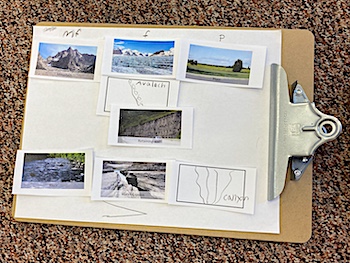SUBJECTS
GRADE
Show Results
Changes in the Earth's Surface
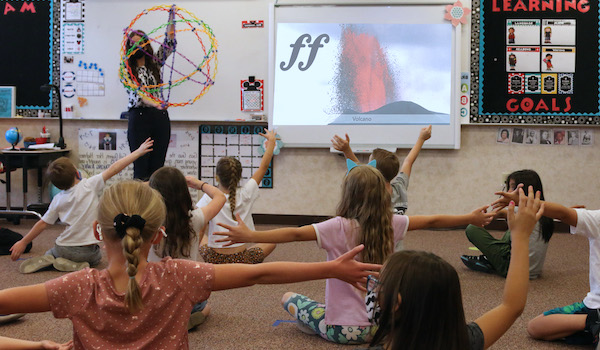
Lesson Summary
- Create a musical model of Earth’s geographic features.
- Adjust music dynamics immediately or gradually based on changes in the Earth’s surface.
- Design and perform a solution to slow or prevent changes.
Lesson Plan and Procedure
Lesson Key Facts
- Grade(s): 2, 5
- Subject(s): English Language Arts, Music, Science, Social Studies
- Duration of lesson: Three sessions, 30-45 minutes each
- Author(s): Emily Soderborg
Session One: Patterns of Landforms and Water on Earth
Show the students a topographic world map.
Teacher: This is a map. What do you see? What do you notice?
Give 30 seconds for students to make observations.
Teacher: Do you know what the purposes of a map are? A map is a type of model--it represents the real thing. Depending on the type of map, it will have different purposes. Maps present information about the world in a simple, visual way.
Hold up a globe.
Teacher: A globe helps us to visualize the shape of Earth and to see bodies of water, continents, and to identify countries. However, we couldn’t use a globe to find a small lake or to get directions to a friend’s house.
Display a city map or show your community on google maps.
Teacher: Instead, we would use a map that shows exact locations of houses and streets in a city neighborhood.
Show the topographic world map again.
Teacher: What do you notice on this map? Do you notice any patterns in the colors used? Do you notice any patterns of the locations of the colors? Do you think there is more water or more land on Earth’s surface?
Help students make observations about the different landforms and bodies of water they see on the map. The students may name some specific landforms that they recognize such as mountains, plains, islands, rivers, lakes, and oceans. As they discuss familiar geographic features, draw attention to them on the map.
Teacher: Land and water cover the surface of Earth. The ground under your feet is part of the land. Earth’s surface has many features such as mountains, valleys, canyons, and floodplains. These features on Earth’s surface are called landforms. These landforms can also be found at the bottom of lakes and oceans. We will be taking a closer look at different landforms and bodies of water. We’ll look at pictures, read about them, and learn a song as well.
Read about one landform/body of water at a time and then sing the corresponding verse from “Rocky Mountain” for each type of landform/body of water. You may sing with a recording or unaccompanied. Have students help find an example of each geographic feature on the topographical map. As you sing, also find the pattern of rhyming words in each verse. The original folk song has verses for mountain, valley, and ocean. Additional verses have been provided, but you could also have students make up their own verses. If students make up their own verses, they will remember them better.
Mountain (hill, plateau, mesa, butte, volcano, sand dune)
A mountain is a raised up part of the Earth's crust, generally with steep sides that show lots of rock. A mountain is different from a plateau because it has a peaked summit, where a plateau is flat across the top. A mountain is larger than a hill, rising above the surrounding land. There are three main ways mountains are formed: fold mountains (plates pushing together), fault-block mountains (forced upwards by faults or cracks in the earth’s crust), and volcanic mountains (magma pushes up from below the earth’s crust). Wind and rain can also help create hills and plateaus.
Rocky mountain, rocky mountain, rocky mountain high
When you’re on that rocky mountain hang your head and cry
Do, do, do, do, do remember me
Do, do, do, do, do remember me
Valley (flood plain, canyon)
A valley is a long low area in Earth's surface. It usually lies between ranges of hills or mountains. Most valleys are formed by rivers that erode, or wear down, soil and rocks. Some valleys are formed through erosion by glacial ice. A floodplain is a generally flat area of land next to a river or stream. It stretches from the banks of the river to the outer edges of the valley. Canyons are V-shaped valleys. Unlike glacial valleys, they are formed by rivers. Rivers typically deepen and widen as they erode, but some rock is resistant to the widening so the valley just gets deeper, creating the canyon.
Sunny valley, sunny valley, sunny valley low
When you’re in that sunny valley sing it soft and slow.
Do, do, do, do, do remember me
Do, do, do, do, do remember me
Plain (grassland, prairie)
A plain is a broad area of relatively flat land. Plains are one of the major landforms, or types of land, on Earth. They cover more than one-third of the world's land area. Plains can be formed from flowing lava, from sediment being left by water, ice, or wind, or by the eroding of rock from hills and mountains.
Flat plain, flat plain, flat plain green
When you’re on the flat plain everything is seen.
Do, do, do, do, do remember me
Do, do, do, do, do remember me
Island (delta, sand bar)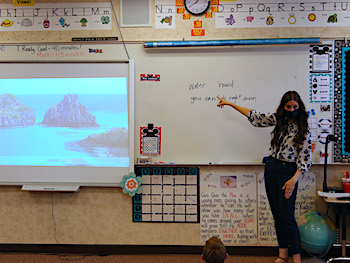
Islands are areas of land that are surrounded by water on all sides. Islands can be formed in different ways: from land being pushed up above the water, from deposits of sand and soil, or from underwater volcanos.
Island with water, island with water, island with water ‘round
When you’re on that island you hope a boat is found.
Do, do, do, do, do remember me
Do, do, do, do, do remember me
Ocean (sea)
An ocean is a huge body of salt water. Oceans cover almost ¾ of the Earth’s surface. Even though the ocean is divided into five main sections (Pacific, Atlantic, Indian, Arctic, and Southern), together they can be seen as one world ocean because they have no real borders, and water flows freely between them.
Stormy ocean, stormy ocean, stormy ocean wide
When you’re on that deep blue sea, there’s no place you can hide.
Do, do, do, do, do remember me
Do, do, do, do, do remember me
River (stream, brook, creek, tributary)
A river is a flowing, moving body of water. Water from a river can come from rain, melting snow, lakes, ponds, or glaciers. Rivers flow downhill from their source. Depending on the size, it may be called a stream, a brook, or a creek. A river moves the water into another river, a pond, lake, or an ocean.
Flowing river, flowing river, flowing river fast
When you’re on that flowing river look at what you’ve passed.
Do, do, do, do, do remember me
Do, do, do, do, do remember me
Lake (pond, reservoir)
A lake is a large body of water (larger and deeper than a pond) within a body of land. As a lake is separated from the ocean, it is not a sea. Lakes do not flow like rivers, but many have rivers flowing into and out of them. They can contain either salt or fresh water. We see lakes in valleys or floodplains at the bottom of landforms.
Calm lake, calm lake, calm lake blue
When you’re on that calm lake you might go fishing too.
Do, do, do, do, do remember me
Do, do, do, do, do remember me
Glacier
Glaciers are huge masses of ice that “flow” like very slow rivers. They form over hundreds of years where fallen snow packs together very tightly and turns into ice. Today, glaciers cover around 10% of the Earth’s total land area. There are many different kinds of glaciers: some high up in the mountains, some that spread out in valleys, and others that come clear down to the ocean.
Huge glacier, huge glacier, huge glacier cold
When you’re on that huge glacier, you’re moving, so I’m told.
Do, do, do, do, do remember me
Do, do, do, do, do remember me
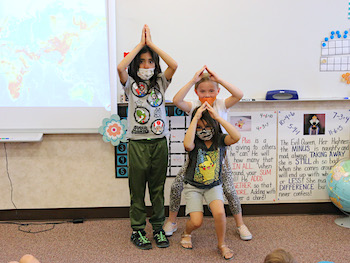 Teacher: We’re going to practice using the information we learned by playing a game. I will give each of you a picture of a geographic feature. You will then create movements to represent your geographic feature and move around the room looking to find those that have the same feature as you. Once you have gathered with others who have the same landform or body of water you have, you will create a combined movement/shape for your geographic feature.
Teacher: We’re going to practice using the information we learned by playing a game. I will give each of you a picture of a geographic feature. You will then create movements to represent your geographic feature and move around the room looking to find those that have the same feature as you. Once you have gathered with others who have the same landform or body of water you have, you will create a combined movement/shape for your geographic feature.
Once everyone has found their group, have students sit where they are. Help students create an ostinato for each geographic feature. An ostinato is a short melodic or rhythmic pattern that repeats, and can be created by repeating the first two or three words in each specific verse over and over while the others in the class sing the whole verse. For example, in the first verse the ostinato could be “Rocky mountain, rocky mountain, rocky mountain, rocky mountain,” and so on.
Look at a topographic map again.
Teacher: A map is a model of the world around us, but we can also create a model using our Rocky Mountain song and pictures of the geographic features. In the map do you see any patterns of landforms and bodies of water? Recognizing the patterns will help us know what order we should put these pictures in.
You may also use another model, a visual of different geographic features, to help guide students.
Teacher: Gravity helps create patterns. When water lands on mountains and hills, it drains down forming rivers, which, over time, form canyons. The rivers move the water to lakes and oceans. We see lakes and oceans in valleys or floodplains at the bottom of landforms. Why do you think we don’t we see lakes or oceans on the tops of mountains or hills?
Have the students arrange the pictures to create a model of the earth’s geographic features. Once they are arranged, point to a specific image and have the students sing the accompanying verse, while the students that created movements for that feature sing the ostinato. Continue pointing and singing in the order the students arranged their geographic features.
Extension: Have students make up additional verses about other kinds of landforms that were not sung about using the correct rhyming scheme and words describing the landform or body of water.
Session Two: Changes in Earth’s Surface
Pre-teach the following vocabulary words:
- landform (review)–a natural feature of the earth’s surface
- surface–the outside part or uppermost layer of something
- weathering–the process of rock being dissolved, worn away, or broken down into smaller and smaller pieces
- erosion–the process when rocks and sediments are picked up and moved to another place by ice, water, wind, or gravity.
- soil–the loose top layer of earth that plants grow in
- sediment–tiny bits of rock (sand, mud, pebbles) that come from other rocks as they are worn down by weathering and erosion. Sediment can also consist of minerals or decomposed plants or animals.
- contrast–being very different from something else
Display the following text for all students to see while doing a shared reading with the class:
Changing Earth
Earth’s surface is always changing. The changes can be slow or fast. They can affect the Earth’s surface in very different ways. The changes can break down landforms or build Earth’s surface up to create new landforms.
Fast Changes
Earth’s surface can change very fast. Volcanoes can erupt and lava can create new landforms. An earthquake is the shaking of Earth’s surface. This is caused by pressure from under the surface. Earthquakes create new landforms. When land moves quickly from high to low ground it is called a landslide. Landslides can happen when there is too much water in the soil or when there are not enough plants to hold the soil in place. Landslides create new landforms.
Slow Changes
In contrast, much of Earth’s surface is changing slowly. During slow changes, landforms made of rocks can be broken down into smaller pieces of rocks in a process called weathering. Once the rock has been weakened and broken up by weathering it is ready for erosion. Erosion happens when rocks and sediments are picked up and moved to another place by ice, water, wind, or gravity. Weathering and erosion slowly cause the landforms to get smaller. After the pieces of rocks are moved, they begin to build a new landform somewhere else. Examples of slow changes include the erosion of mountains or the shaping of canyons.
(Text adapted from Utah OER Textbooks: 2nd grade SEEd)
During this shared reading, help students focus on comprehension, while also modeling decoding strategies and/or fluency skills. You may model how you use visual, syntax, or meaning clues to decode words. You may practice fluent reading by having students chorally read part of the text that you’ve already read aloud.
Fast Changes
Teacher: Just like the earth’s surface can change, the dynamics of a song can change too. The dynamics refer to the volume of the music, ranging from very quiet to very loud. Music uses Italian terms to describe aspects of the music, so we will be using Italian words to describe our dynamics. When we want music to be loud, it is labeled forte, with a curvy “f.” When we sing forte this does not mean yell. We use strong singing voices, without hurting our voices. To add volume (which means make it louder) we send out more air. Try holding your palm of your hand in front of your mouth. When we want music to be quiet, it is labeled piano, with a “p.” Sing “ah” quietly, at a piano level, and feel how much air you feel on your hand. Now, sing “ah” louder, at a forte level. Can you feel more air against your palm? For most music, we usually sing at a medium loud volume, labeled in music as mezzo forte, which is how we have been singing “Rocky Mountain.” Using the song and the model of geographic features we created, we are going to show fast and slow landform changes by also changing the dynamics.
Put up pictures of a volcano, an earthquake, and a landslide.
Teacher: These are fast landform changes. If we add any of these in our song, our dynamics are going to change immediately. If we add a landslide to our model, we will immediately change the dynamic to “f” or forte. What does forte mean? (loud) Landslides happen quickly and can make a lot of noise when they happen. We will sing “Rocky Mountain” but when I point to the landslide picture, you will immediately change the dynamics to forte. Let’s try it.
Teacher tip: To conduct students singing, you don’t have to be able to conduct specific patterns. You can conduct dynamics by moving your hands in and out like you are holding a beach ball. When it is quiet, the ball is small enough that your fingers are touching. As the volume increases, you would show the ball getting bigger. Another great way to help students visualize dynamics is by using a Hoberman sphere.
Start singing “Rocky Mountain” at mezzo piano. When you point to the landslide picture, see if the students immediately change the dynamics to forte and continue singing at that volume through the end of that verse.
Teacher: When landslides happen, new landforms are created. For example, when hillsides collapse in a landslide it can create a valley, or a landslide may create a lake when the rocky material dams a stream. What new landform do you think this landslide created? Because of the landslide we will change the picture that comes next in our model.
Change the picture and sing the verse for the new landform. Select a dynamic level to sing.
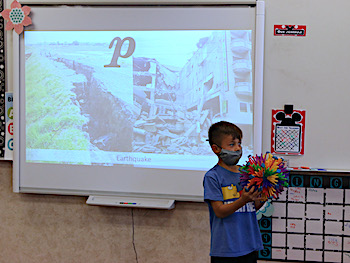 Teacher: Another fast landform change is an earthquake. If we add an earthquake to our model, we will immediately change the dynamics to piano, shown in the music as “p.” When an earthquake happens, it is felt more than heard. The force does make sounds, but they are often too low or too high for our ears to hear all the sounds. People say what they do hear sounds like a plane engine taking off in the distance. What does piano mean again? (quiet) We’ll sing a verse from “Rocky Mountain” starting at mezzo forte (medium loud) but watch for when I point to the earthquake and be ready to change the dynamics to piano. Ready?
Teacher: Another fast landform change is an earthquake. If we add an earthquake to our model, we will immediately change the dynamics to piano, shown in the music as “p.” When an earthquake happens, it is felt more than heard. The force does make sounds, but they are often too low or too high for our ears to hear all the sounds. People say what they do hear sounds like a plane engine taking off in the distance. What does piano mean again? (quiet) We’ll sing a verse from “Rocky Mountain” starting at mezzo forte (medium loud) but watch for when I point to the earthquake and be ready to change the dynamics to piano. Ready?
Select a verse of “Rocky Mountain” to sing, changing dynamics part way through the verse.
Teacher: When earthquakes happen, new landforms are created including new mountain ranges, hills, valleys, lakes or causing landslides. These are only a few of the options. What new landform do you think this earthquake created? Because of the earthquake we will change the picture that comes next in our model.
Change the picture and sing the verse for the new landform.
Teacher: A volcano also creates fast landform changes. If we add a volcano to our model, we will immediately change the dynamics to fortissimo, show as “ff,” meaning very loud. A volcano erupting is the loudest sound we’ve ever known in our Earth’s history. Remember as we sing fortissimo we do not shout, but sing strong and with lots of air. We’ll sing a verse of “Rocky Mountain” starting at mezzo piano (“mp”–medium quiet). Watch for when I point to the volcano to change the dynamics to fortissimo. What does fortissimo mean again? (very loud)
Sing any “Rocky Mountain” verse changing dynamics part way through the verse.
Teacher: When volcanos erupt, new landforms are created made of lava, ash, and other materials. These might be gently sloping or steep mountains, flat plateaus, or if the volcano collapses, it can leave a huge hole, which if filled with water may form a lake. What new landform do you think this volcano created? Because of the volcano we will change the picture that comes next in our model.
Change the picture and sing the verse for the new landform, making sure to select a specific dynamic to sing.
Practice changing the landforms as fast changes happen on Earth’s surface a few more times, allowing students to conduct the dynamic changes.
Slow Changes
Teacher: We have been changing our dynamics immediately. But, just like landforms, changes can happen slowly as well. These changes happen little by little, over time. As the landforms are weathered, the rock is dissolved, worn away, or broken down into smaller and smaller pieces. Weathering can happen when plants break up rocks with their growing roots or plant acids help dissolve rock. Another way weathering happens is when water gets into small cracks in rocks. When the water freezes it expands and the cracks are opened a little wider, eventually breaking large rocks into smaller rocks and gravel. Over time, water can also dissolve some kinds of rocks. Wind causes weathering by blowing bits of material against cliffs and large rocks. This wears and breaks the rock down into sand and dust. As weathering happens, our dynamics will gradually get quieter and quieter, which in music is called a decrescendo. We will start singing at mezzo forte. What does mezzo forte mean again? (medium loud) You will have to watch and follow closely to stay right with me.
Note: It is harder for students to gradually change dynamics than to immediately change dynamics.
Start singing a verse of Rocky Mountain. Throughout the entire verse gradually decrescendo by getting more and more quiet.
Teacher: Once the rock has been weakened and broken apart by weathering it is ready for erosion. Erosion happens when rocks and sediments are picked up and moved to another place by ice, water, wind, or gravity. We will use a crescendo, which is to gradually get louder and louder, to show the erosion. Make sure you are using your breath to get louder, and not hurting your voice by yelling.
Start singing a verse of Rocky Mountain. Throughout the entire verse gradually increase the volume.
Teacher: Weathering and erosion work together to create new landforms. These landforms might include canyons, arches, valleys, islands, or many other landforms. What new landform do you think this weathering and erosion created? Because of the weathering and erosion we will change the picture that comes next in our model.
Sing the new landform verse starting at a mf dynamic. Decrescendo through the first half of the song and then crescendo starting at the chorus and building to the end of the song.
Practice gradual dynamic changes as needed.
Teacher: We have been exploring lots of ways Earth’s surface changes. What are some of the vocabulary words we have learned?
Have students share out the vocabulary words from this session. If they don’t remember them all, show the vocabulary words and review them: landform, surface, weathering, erosion, soil, sediment, contrast, dynamics, forte, piano, mezzo, fortissimo, crescendo, and decrescendo.
Teacher: Do you remember what the vocabulary word, weathering, means? Weathering is the process of rock being dissolved, worn away, or broken down into smaller and smaller pieces. We’ve looked at ways this happens slowly because that is what happens in most cases of weathering. However, what fast change that we explored today is also an example of weathering? Earthquakes! Earthquakes can break rocks into smaller and smaller pieces. Now, do you remember what erosion means? Erosion is the process when rocks and sediment are picked up and moved to another place by ice, water, wind, or gravity. What fast change is an example of erosion? Landslides are a fast type of gravity erosion as rocks and soil are moved from high to low very quickly.
Teacher: We’re going to show, with our dynamics, how Earth’s surface is always changing, and how this can happen through fast or slow changes. Watch as I conduct “Rocky Mountain.” My dynamics will constantly be changing—sometimes fast, and sometimes slow. You’ll have to watch closely to be able to follow right with the changes I show.
Sing through all the verses of “Rocky Mountain” changing the dynamics throughout the song. Go back and forth between sudden changes and gradual crescendos and decrescendos.
Extension: Challenge the students to see if they can figure out what landform changes they sang, just from the dynamics used, and the speed of the changes.
Session Three: Slowing or Preventing Changes
Teacher: We talked about how there are fast and slow changes constantly happening to Earth’s surface. Two ways these changes happen are through weathering and erosion. We discussed how at times weathering and erosion can occur quickly, but usually they refer to slow changes. For the rest of this session, as we refer to weathering and erosion, it will mean the slow processes. We’ll refer to the fast changes by their specific names: earthquake, landslide, and volcano. As we read together, see if you can find any of the vocabulary words we have been learning.
Shared Reading
Earth’s surface is always changing. These changes, big or small, can cause problems for us. Soil is the upper most layer of Earth’s surface. The soil is where we grow our food. If there is a big storm, too much water can run off. This water can take too much soil and land with it. This is a problem because we need soil for gardens, farms, and healthy habitats for animals. The wind can also pick up loose and dry soil and erode it. Water and wind are like thieves when it comes to soil. They both can carry it away. Wind and water play a major role in erosion. We know that soil is gained and lost from areas. We know it needs to be protected. Scientists and engineers want to learn about ways to prevent erosion.
Teacher: In our musical model, any time we think like scientists and engineers to figure out a way to slow or prevent landform changes in our music, we can go back to our original dynamics. We’ll get to practice dynamic changes as we arrange music today. To show you the entire process, I am going to create an arrangement of “Rocky Mountain” that models all of the steps we have learned about: landforms, bodies of water, slow or fast changes, and preventing changes. Using the engineering design steps, I will create my own version of the song that changes the dynamics.
 Teacher: First, we need to select at least two landforms and one body of water for our initial model. We will need to make sure we arrange these to follow the pattern of landforms and bodies of water. Next, we will select a slow or fast change in the landform and define the problem this change creates. We will then research and gather information about possible solutions. Next, we will design a solution by looking at all the information we have gathered and selecting the option we think will best reduce the changes to the shape of the land. Finally, we will test our solution by performing our arrangement with the dynamics changing according to the model we created.
Teacher: First, we need to select at least two landforms and one body of water for our initial model. We will need to make sure we arrange these to follow the pattern of landforms and bodies of water. Next, we will select a slow or fast change in the landform and define the problem this change creates. We will then research and gather information about possible solutions. Next, we will design a solution by looking at all the information we have gathered and selecting the option we think will best reduce the changes to the shape of the land. Finally, we will test our solution by performing our arrangement with the dynamics changing according to the model we created.
Teacher: For my arrangement, I will start with a lake, then I will put mountains. Next, I will put a river. My third geographic feature will be a canyon. I will draw a picture of a canyon because this is a landform I don’t have a picture for in my packet of images. Finally, I will put a valley. Help me double check that I have used at least two landforms and one body of water. Does my order follow the pattern of landforms and bodies of water we saw earlier? It doesn’t! The lake shouldn’t be at the top of the mountain. Large bodies of water are found at the base of landforms rather than the top. To show a correct landform pattern, I’ll move the lake to the last part of my model, so it is in the valley at the base of the mountain. We can use the verses for mountain, river, valley, and lake, but we haven’t sung a verse about a canyon yet. What kind of canyon is this? It’s a narrow canyon. What’s another way to describe the canyon? Deep! Now, what’s a word that rhymes with deep? Keep, creep, leap, steep, sweep. So many good ideas. I’m going to say, “When you’re in that narrow canyon, the walls are very steep.”
Narrow canyon, narrow canyon, narrow canyon deep
When you’re in that narrow canyon, the walls are very steep
Note: This is just one idea for how you could have students help you come up with new verses. Going through the metacognitive process with students will help them know what they need to do to come up with their own verses later.
Sing through the five verses of the song, pointing to the model created: mountain, river, canyon, valley, lake. Have students tap the beat while singing each verse.
Teacher: I have completed my initial geographic features model, so I now need to select at least one slow or fast landform change and decide where in my model it will be placed. I am going to select water weathering and wind erosion because I know weathering and erosion work together. I’m going to put the weathering in the valley, where the force of raindrops breaks apart the bare soil. Because of this I will have a decrescendo through the first half of the valley verse, and then the wind will erode the soil by picking up the topsoil and blowing it somewhere else. This means I will have a crescendo through the chorus of the valley verse.
Sing through the valley verse with the decrescendo and crescendo. Help students recognize the importance of following the conductor to start, stop, and stay together as they sing.
Teacher: Now, I need to research ways I can slow the weathering and erosion of the valley’s soil. Our research today will be looking at options of what others have already done. Which of these pictures look like they might help slow down or prevent farmland soil from weathering and erosion?
Look through the following pictures and descriptions:
- grass and other ground cover
- shrub and tree windbreaks
- level farm techniques
- retaining walls
- dams/dikes/levees
- hillside drainage
- additional supports and anchoring
- emergency preparedness
Plants (grass and other groundcover): People can slow down or stop the movement of land by covering it with different materials. As plants grow in soil, their roots hold the land in place. Soil needs plants to protect it. One way this is done is as farmers leave some vegetation in their fields rather than harvesting it all.
Windbreaks: Planting trees along fields can block the wind. By slowing the wind, it prevents the soil from blowing away.
Level farm fields: Steep slopes increase water erosion. Some farmers use special techniques to keep their fields level. Level fields are in much less danger from erosion.
Retaining walls: People can also build walls to slow down or stop the movement of land or changes to landforms. Retaining walls help keep a slope stable so landslides don’t have as serious an impact.
Dams, levees, and dikes: These have a simple but important job: they hold back water. People build levees to keep rivers or lakes from flooding low-lying land during storms. A temporary way of holding back water is through piling sandbags.
Hillside drainage: People might also install systems to provide drainage to a hillside to keep the soil from getting too saturated. Drainage systems lower the water level inside a potentially unstable hillside, helping it withstand landslides.
Additional supports and anchoring: While you can’t prevent earthquakes and volcanos from happening, there are some ways to secure your property to minimize damage and keep your home and those that live there safe. Installing additional support and anchoring inside and outside your home can help reduce the movement during earthquakes.
Emergency preparedness: For both earthquakes and volcanos, it is important to have a disaster plan and prepare a disaster supplies kit for your home and car. The disaster kit should include a first aid kit, canned food and a can opener, bottled water, battery-operated radio, flashlight, protective clothing, dust mask, goggles and sturdy shoes.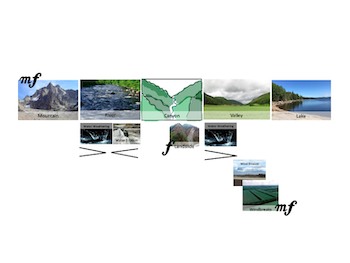
Teacher: Several of these things could help, couldn’t they? I’m going to select one to put in my arrangement. Planting shrubs and trees as a windbreak will help slow the erosion of the valley topsoil by blocking the wind from blowing the dirt away. In my arrangement, as soon as I reach the erosion image, I will add in the windbreak image and my dynamics will immediately go back to my original dynamics, mezzo forte. Let’s try the valley verse again.
Sing through the valley verse with the decrescendo and when the students get to the chorus immediately sing using mezzo forte dynamics for the rest of the chorus.
Teacher: We are now going to test my solution by singing through my entire arrangement.
Sing through the entire arrangement together, pointing to the images to guide the students, and adjusting dynamics appropriately.
Teacher: I don’t have to stick with just one landform change. I could put in other changes in places they might happen too.
Some additional ideas are included on slide 51.
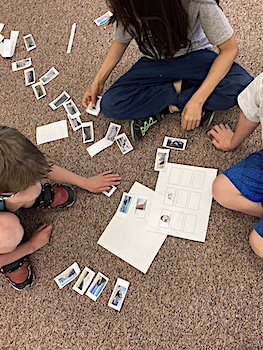
Arrange students into small working groups. Three students in a group are optimal. Hand out the “Changes in the Earth’s Surface Composition Cards.” Display the engineering design process again (slide 38). Review which pictures in the set of cards go in each category: landforms, bodies of water, fast changes, slow changes, slowing or preventing changes. Give students time to work through the engineering design process to create their music arrangements. This could include writing new lyrics for different verses about additional landforms or bodies of water they want to use and drawing pictures for any geographic features, changes, or solutions they think of that are not represented in the images provided. Students might benefit from having a printed copy of the lyrics for each verse, so they can remember all the verses as they select which verses to sing in their arrangement.
Once students are finished, over the next few days have them explain the choices they made and then conduct the class through their music arrangement.
Learning Objectives
- Develop and use models illustrating the patterns of landforms and water on Earth.
- Show how changes in Earth’s surface happen quickly or slowly.
- Design solutions to slow or prevent changes to the shape of the land.
- Explore the effects of changing dynamic levels in a song.
- Sing “Rocky Mountain” in-tune.
- Compose additional verses for “Rocky Mountain.”
- Identify and use information on a map and on a globe
- Determine the meaning of words and phrases in a science text.
Utah State Board of Education Standards
This lesson can be used to meet standards in many grades and subject areas. We will highlight one grade’s standards to give an example of application.
Grade 2 Science with Engineering Education (SEEd)
- Strand 2.1: Changes in the Earth’s Surface
- Standard 2.1.1: Develop and use models illustrating the patterns of landforms and water on Earth. Examples of models could include valleys, canyons, or floodplains and could depict water in the solid or liquid state. (ESS2.B)
- Standard 2.1.2: Construct an explanation about changes in Earth’s surface that happen quickly or slowly. Emphasize the contrast between fast and slow changes. Examples of fast changes could include volcanic eruptions, earthquakes, or landslides. Examples of slow changes could include the erosion of mountains or the shaping of canyons. (ESS1.C)
- Standard 2.1.3: Design solutions to slow or prevent wind or water from changing the shape of land. Define the problem by asking questions and gathering information, convey designs through sketches, drawings, or physical models, and compare and test designs. Examples of solutions could include retaining walls, dikes, windbreaks, shrubs, trees, and grass to hold back wind, water, and land. (ESS2.A, ESS2.C, ETS1.A, ETS1.B, ETS1.C)
Grade 2 Music
- 2.M.P.3: Explore the effects of various timbres, dynamic levels and tempos using voice, movement, and simple instruments.
- 2.M.P.4: Sing folk, traditional, and call-and-response songs in tune, using a natural, unstrained voice.
- 2.M.P.9: Respond to dynamics symbols of piano and forte.
- 2.M.P.11: Perform music with a specific purpose, expression, and technical accuracy; watch and follow the conductor to perform dynamics and to start, stop, and stay together; and demonstrate appropriate performance behavior.
- 2.M.CO.1: Describe how music relates to personal, social, emotional, and intellectual development, use life experience and additional content knowledge to inspire and respond to music, and deepen understanding of another content area through music.
Grade 2 Social Studies
- Standard 2.2.2: Interpret and construct physical maps using the title, key, symbols, 8-point compass rose, cardinal directions, and alphanumeric grids.
- Standard 2.2.3: Identify examples of major geographical features in their local region, state, and country and their significance for the people who live there.
Grade 2 English Language Arts
- Standard 2.R.4: Read grade-level text with accuracy and fluency to support comprehension. (RL & RI)
Equipment and Materials Needed
- PowerPoint with all images
- Maps and globe
- Images of landforms and bodies of water
- Images of slow and fast changes to landforms
- Images of weathering and erosion
- Images of ways to slow or prevent landform changes
- Physical globe
- “Rocky Mountain” sheet music
- “Rocky Mountain” vocal recording
- “Rocky Mountain” instrumental recording
- “Rocky Mountain” additional song lyrics
- Shared Reading for Slow and Fast Changes
- Student research on slowing or preventing changes to Earth's surface
- Changes in Earth's Surface Group Composition Cards
Additional Resources
- https://emedia.uen.org/courses/utah-oer-textbooks-2nd-grade-seed/view
- https://www.uvu.edu/education/docs/seed/seedpod-2ndgrade.pdf
- https://gpm.nasa.gov/education/sites/default/files/lesson_plan_files/Models%20of%20Land%20and%20Water%20TG.pdf
- https://gpm.nasa.gov/education/sites/default/files/lesson_plan_files/LandformsTG.pdf
Image References
Images 1-4: James Huston
Images 5-8: Emily Soderborg

www.education.byu.edu/arts/lessons
 Download
Download